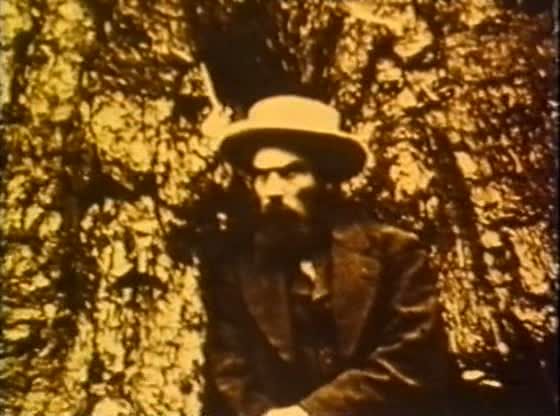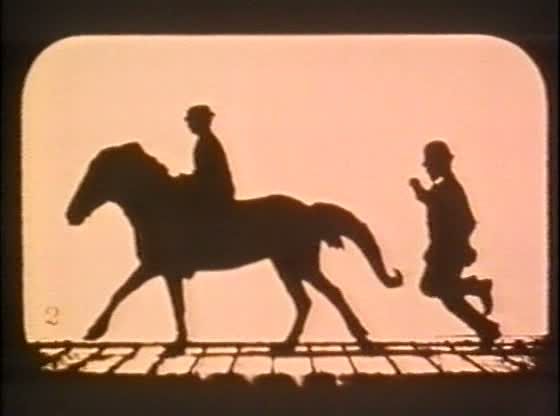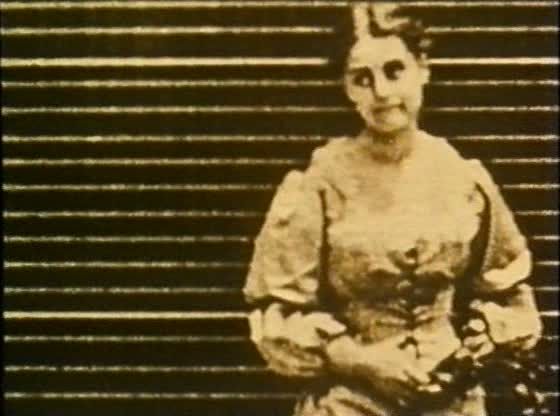
The photographer Eadweard Muybridge can be considered an early pioneer of the development of motion pictures, even though his work preceded the official birth of the cinema. Muybridge is most famous for his sequences of still images that captured animals and humans in various stages of motion: these images, strung together as stills or projected with Muybridge's zoopraxiscope (a primitive motion picture prototype), not only represented steps towards the development of the cinema, but in the realm of science, completely changed the nature of accepted thinking about animal locomotion. Eadweard Muybridge, Zoopraxographer is a film essay by Thom Andersen that explores Muybridge's life and work, first in the form of a conventional documentary biography, and then, more provocatively, as a coherently argued work of criticism that examines the ideas and associations evoked by viewing Muybridge's pre-cinematic oeuvre at a remove of almost a hundred years.
Roughly the first half of Andersen's film is devoted to a biography of Muybridge, accompanied by images from the photographer's work. The material is informative and interesting, if not necessarily exciting, and it establishes the context of Muybridge's times and his photographic background. The narration, by the actor Dean Stockwell, is deadpan and purposefully dry, straightforwardly recounting Muybridge's early photographic and journalistic endeavors. But Andersen's perceptive, incisive perspective on this material is revealed in key ways, as when the narrator says that it was "manifest destiny" that gave Muybridge passage — on a commercial ship — to Central America, where the photographer documented the laborers on sugar plantations. The voiceover's wry reference to Muybridge reworking his name as a Spanish sobriquet has a subtle hint of mockery in it, subverting the objective tone of the words themselves.
Andersen's perspective is even more pointedly revealed in the sequence where he recounts Muybridge's marriage, his subsequent discovery that his wife was cheating on him, and then his very public murder of her lover. The narration retains its dry, serious tone, but Andersen slowly zooms in on an image of Muybridge, his eyes hooded, a bushy beard covering the lower half of his face, fixing the camera with a sinister glare. Then the story takes a really unexpected turn when Andersen reveals that Muybridge, at his murder trial, initially pleaded insanity but was in fact acquitted entirely, on the grounds of "justifiable homicide." The subtext is obvious: if the slow zoom on Muybridge's impenetrable face encouraged consideration of what kind of man this was, the trial's outcome suggests just how different this era was from our own. This will be a theme that Andersen will pick up, in a very different way, in the analytical second half of his film, but here it's already an undercurrent, pointing to the unbridgeable gap between the pre-cinematic 1800s and our own time.

Once Andersen establishes the basic details of his subject's life and the nature of his work, the filmmaker delves into analysis with a section explicitly titled "Analysis" (the previous sections, mirroring Muybridge's scientific terminology, were titled "Prospectus" and "Catalogue"). Andersen then immediately leaps into the substance of Muybridge's work, particularly the series of photographic sequences, mostly of people, that he made at the University of Pennsylvania from 1883 to 1886. Muybridge meticulously documented and quantified his work, balancing between scientific rigor and an aesthetic, emotional component that prefigures the artistic/industrial divide that would be worked out in the subsequent early cinema of Edison, Lumière, and other pioneers. What's fascinating about Muybridge's work, to Andersen, is that tension between the functional/scientific and the social/artistic/emotional. Many of Muybridge's subjects were naked men and women, and Andersen juxtaposes these images against the photographer's similar documents of people in the clothing of the era: restrictive, long, formal, conservative.
Muybridge's work is presented as a radical statement in an era in which sexuality and nudity were considered beyond the pale. What's especially provocative about his images to Andersen, however, is how ordinary the presentation of nudity is, how casual. Muybridge's images depict men and women performing athletic feats, but also ordinary chores or activities as prosaic as drinking tea or getting out of bed. Andersen is probing the tension inherent in these images, even now: the scientific setting, with its abstract grid backdrop, contrasts against the casual nudity of the subjects, so that each image attempts to capture natural activity, but does so in an utterly artificial way. This means that Muybridge's photographs, balanced as they are between scientific inquiry, artistic portraiture, documentary representation, and even social commentary, are especially rich sources for the consideration of what a photographic or cinematic image represents and what can be represented by the image.
Andersen also makes the (debatable) point that the nudity in Muybridge's work was especially subversive because it did not resort to the pictorial conventions — lyricism, romanticism, idealization — that were and are used to aesthetically represent nudity in much popular art. In fact, it's likely that Muybridge's photos were as accepted as they were precisely because of their aura of scientific importance, because the nudity could be justified, not as prurient, but as observational and clinical. Andersen is right, though, that Muybridge's images are especially fascinating as early examples of the verité impulse in image-making, whether in photography or the nascent cinema. In talking about Muybridge's pre-zoopraxiscope work, Andersen points out that Muybridge's on-location photography and naturalistic depictions of unstaged, unposed scenes were breaks from the norms of the time, when most photography was made in studios, with rigid poses and very formal conditions. Muybridge, almost from the beginning of his career, had the impulse to photograph the world as it was, to take pictures even of innocuous clouds and trees, and he carried this documentary impulse over into his scientific work. This is just one respect in which Muybridge presaged the "actualities" of the early cinema, with its depictions of trains pulling into stations and athletes performing feats.

One of Andersen's first deconstructions of Muybridge's images in his "Analysis" is to translate Muybridge's tabulations of times recorded and not recorded into a cinematic reconstruction that restores the element of time to these individual still photos. Andersen represents the times between images with black spaces, so that the images seem to flicker across the screen, pulsating, as the voiceover poetically describes the relationship between the images, which freeze a fraction of second forever, and all the unrecorded time that exists in between photographs but has not been immortalized. That the images, once animated in this fashion, still create the illusion of movement simultaneously exalts the magic of the cinema and laments the non-recorded images that linger, like unseen ghosts, in between each frame of the film.
Andersen is making the very interesting argument that, while Muybridge's system, with its multiple cameras, was an oddity that had little to do, from a technological standpoint, with the eventual invention of the cinema as we know it, from a philosophical and physiological standpoint Muybridge was laying the groundwork for the innovations of Edison and Lumière. What Muybridge's work proved was that a finite series of images, projected together and interrupted by black frames, could, through the phenomenon of the persistence of vision, create the illusion of movement. Muybridge, like all later filmmakers, was taking still images — frozen snapshots of particular moments in time — and reanimating them into the forward motion and flow of moving time. He was reintroducing time to the static image, and towards the end of this film Andersen illustrates the point by recreating one of Muybridge's most provocative and evocative images, the slow progress of two naked women gradually moving closer together until they lightly kiss. Andersen's flickering recreation returns Muybridge's influence to the cinema, using modern means to duplicate the strobing but sensuous quality of Muybridge's primitive proto-cinema. As Andersen presents it, there's something poignant about the dead-end status of Muybridge's invention; he was held back by the lack of technical advances that would come too late for his work, but he was already thinking in ways that would be developed to fruition in the more direct precursors to the modern cinema.
In Eadweard Muybridge, Zoopraxographer, Andersen has created a work of criticism in film form, not only providing a biography of Muybridge and a chronicle of his influential work, but examining the implications of that work in sociology, art, the science of perception, and sexual mores. Andersen's commentary, as drolly recited by Stockwell, is at times dryly ironic (Muybridge "was the first and only zoopraxographer") and at times seems bemused and peeved by the sexual repression of Muybridge's era — and the enduring puritanical spirit that has stretched into the present as well. Muybridge thus becomes an unlikely icon for the sexual revolution, a precursor not only of the cinema but of a sensibility of clear-eyed examination that doesn't flinch away from nakedness, that's concerned with discovering the truth of human existence in all its unglamorous ordinariness. Andersen is a sharp, perceptive critic whose consideration of Muybridge opens up into social criticism, film theory, sexuality, aesthetics and technology. He is doing the work of all the best critics: looking closely and intently at these flickering images and finding a wealth of ideas to be drawn out and connections to be made.

10 comments:
Absolutely brilliant. One of my favorite reviews here, Ed. A terrific criticism of what appears to be terrific criticism.
I've been meaning to watch this film ever since I saw LOS ANGELES PLAYS ITSELF. This review's just pushed the impetus.
Your review has piqued my interest, yet a quick google search doesn't bring up any online sources or DVD releases. Is this available to be readily watched, Ed?
Thanks a lot, JAFB. Los Angeles Plays Itself is next on my list, Andersen is such a perceptive critic. I love the form of film-as-film-criticism, it's such a rich and vital area that hasn't been explored by very many.
Troy, unfortunately I think there's no DVD or legit online viewing opportunity for this great film. I saw it by downloading a torrent, which seems to be the only way to get ahold of it for now outside of whatever periodic screenings might happen. It's a shame that Andersen's films are so tough to find.
"Andersen also makes the (debatable) point that the nudity in Muybridge's work was especially subversive because it did not resort to the pictorial conventions — lyricism, romanticism, idealization — that were and are used to aesthetically represent nudity in much popular art. In fact, it's likely that Muybridge's photos were as accepted as they were precisely because of their aura of scientific importance, because the nudity could be justified, not as prurient, but as observational and clinical. Andersen is right, though, that Muybridge's images are especially fascinating as early examples of the verité impulse in image-making, whether in photography or the nascent cinema."
And JAFB's review of LOS ANGELES PLAYS ITSELF is one for the ages. Ever since I read that I have been intrigued by Andersen's work, but still have not managed to negotiate any of it, much less this seemingly essential film essay, so remarkably framed here. We all know well of the dryness of Dean Stockwell's voice from BLUE VELVET and it appears that Andersen has selected well on that count. Anyway, I'd dare to say that if you were making out a resume, this intricate and fascinating marathon esay might be one of the first deserving of mention from the ONLY THE CINEMA archives. It's that good, as JAFB states above.
Thanks, Sam. Los Angeles Plays Itself is on my list to see soon, and once I do get a chance to watch it I'll be sure to check out JAFB's essay on it. I'm looking forward to seeing more of his work.
Wow! I saw this back in the mid to late 1970's at MOMA in New York and have not heard much about it since. Fascinating film and a great review on your part. A really tough film to find.
Thanks, John. Yeah, it's definitely not one that shows up too often, but it's worth seeking out. Glad you got a chance to see it back when it came out; it seems like not many have seen it.
I just watched this over the weekend and now reading back over your review, it seems you've summed things up on the film quite well.
As you mention, the moment in the film when Muybridge's marriage and subsequent murdering of his wife are layed out is a brilliant bit of filmmaking -- combining the dry words of Stockwell, the fiendish look on Muybridge's face, the off-kilter soundtrack, and the alien look of the sepia toned photo combined to actually make a chilling moment -- which Andersen then playfully disregards as he moves into the next segment.
I kind of like that Andersen doesn't really try to make Muybridge out to be some kind of forgotten genius and the true inventor of cinema, but honestly shows him to be an eccentric photographer/scientist who wasn't concerned with the social norms of the time. Also, as you state -- the bits of dry humor a sly comments that Andersen puts in here and there is a nice touch. He seems to be winking at the audience a lot more than you would typically expect from an academic film essay with bone dry narration that's going to be shown at a museum.
Lots more good stuff in the film too (and I feel like I'm repeating what you already wrote -- like I said, you hit everything pretty much dead on in the review) like the points on his non-adherence to the social mores of the time, his true place in the history of the creation of film, and how Andersen ultimately ties in the Muybridge slides with modern day film in the last scene.
So glad you tracked this one down and enjoyed it as much as I did, Troy. As you say, the film doesn't try to make too much of Muybridge's place in history, and I appreciate that too. It's a very even-handed view of Muybridge and his work, and more importantly it displays a real, deep appreciation of his art regardless of its historical place.
Great review! Does anyone know of any critical essays out there about this fascinating film?
Post a Comment